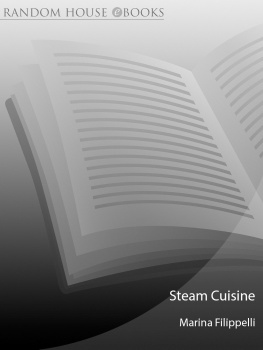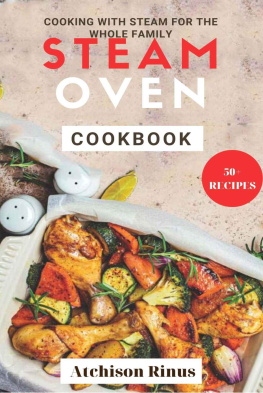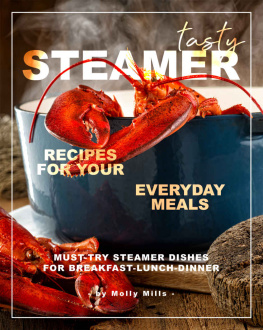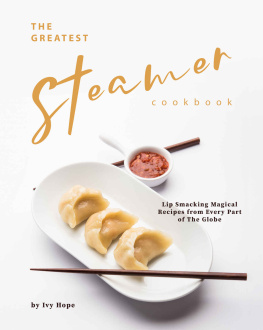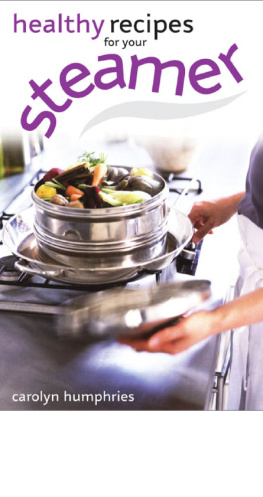Contents
List of Recipes
About the Book
Steaming is one of the healthiest, simplest and most versatile cooking methods around: not only does it retain the nutritional qualities of ingredients more than any other technique, it doesnt require any fat. So if youre trying to improve your diet or simply want your food to be as tasty as it can be, its the perfect option.
But steamed food doesnt mean dull food you can make delicious dim sum, couscous and puddings, as well as spicy meat dishes, perfect rice and mouth-watering fish dishes in minutes. All you need is a pan of water and a rack! Around the world, steaming has long been a popular cooking method, and Steam Cuisine includes exciting recipes from China and South-East Asia such as Prawn and pork won ton, Scallop and coriander dim sum and Duck rolls with spring onion.
Theres also inspiration from the Middle East and North Africa, with the likes of Whole quail with a pomegranate marinade and Seven vegetable couscous. In the Mediterranean wonderful ingredients are commonly wrapped in a paper envelope to be steam-baked and opened at the table, such as Mussels, monkfish and clams in a saffron broth and Lemony chicken parcels with garlic, chard and chilli. While in Britain, the sweetest, most indulgent puddings are steamed and here are some healthy takes on classics like Sticky pecan toffee pudding and Chocolate puddings.
With over 100 tried-and-tested, easy-to-follow recipes and full-colour photographs throughout, Steam Cuisine will open up a fresh way of cooking and a new world of taste.
About the Author
Marina Filippelli is a food writer and contributor to publications including Tesco Magazine, Essentials Magazine and Ideal Home. She has also written books on Italian and Latin American cookery.
STEAM CUISINE
MARINA FILIPPELLI
OVER 100 QUICK, HEALTHY AND DELICIOUS RECIPES FOR YOUR STEAMER

Introduction
Steaming is a gentle cooking method and undoubtedly one of the healthiest, as it retains the nutritional qualities of ingredients more than any other technique and doesnt require any added fat. Being perceived as the healthy low-fat option, however, has contributed to the misconception that steaming is a technique used to create uninteresting, bland food. If this is your view, think again!
You only have to look at how cooks in China, Japan and South-East Asia use steaming in their most delicious recipes everything from vegetables to fish and seafood, meat and poultry, and of course rice and egg dishes to appreciate what an exciting cooking method it is. In Morocco, its used to create wonderful couscous meals, and in France and Italy, the technique of wrapping wonderful ingredients in a paper parcel to be steam-baked opens the door to an array of flavour and texture combinations. Meanwhile, in Britain the most indulgent puddings are steamed. This book draws on such classic recipes from around the world, giving them a healthy twist.
THE SCIENCE OF STEAMING
When steam from boiling water comes into contact with raw food it condenses onto the foods surface and seals it faster than it would if the food were boiled. That is because, as Harold McGee explains in his wonderful book On Food and Cooking, water vapour has more energy than liquid water. What this means in practical terms is that steaming cooks thin cuts of fish, meat, poultry or vegetables extremely quickly, sealing in their juices and goodness.
When steaming thicker cuts of meat or fish, however, you run the risk of overcooking the surface of the food while you wait for the centre to cook. This is the last thing we want, as it draws out the moisture from the food, regardless of the fact that it is cooking in a moist atmosphere. So, when steaming dishes that will take more than a few minutes, you should lower the temperature of the water to a simmer. This will create a lesser concentration of steam, lower the overall temperature of the atmosphere in the pan and, in turn, slow down the speed with which the outer surface of the food cooks.
Foods that need a longer cooking time, such as whole fish, whole birds or even tough or fibrous meats like ribs and lamb shanks, also benefit from being protected from ) also has the same effect.
Another indirect method of steaming is to cook the food in a closed heatproof container such as a pudding basin or a ramekin. The steam heats the container, which conducts the heat onto the food. This slow, very controlled method is perfect for steaming cakes and egg-based recipes such as custards.
STEAMING AND YOUR HEALTH
One of the great advantages of steaming is that the flavour and goodness of the food is preserved. The food cooks in the vapour created by steaming liquid rather than in the cooking liquid itself, therefore there is less loss of water-soluble vitamins than there would be with boiling or poaching. Also, because steaming doesnt need added oil or fat of any kind unlike, say, stir-frying, pan-frying or even grilling it is probably one of the healthiest methods of cooking.
Not all steamed recipes are super-healthy or low in fat, however. Many South-East Asian dishes use coconut cream or milk, for instance, while traditional British steamed puddings are made with butter or suet. Since the healthy reputation of steaming is probably what attracted you to buying this book in the first place, youll find most of the recipes included here will stay true to the squeaky-clean image of steaming. Every effort has been made to keep the recipes as healthy as possible, and where naughty ingredients are called for (mostly in the desserts!), lower-fat alternatives are used so even the most indulgent recipes are healthier than their taste suggests.
DELICATE YET FLAVOURSOME
Think of steaming and a healthy, delicate-tasting meal comes to mind. Sometimes a wholesome dinner of plainly steamed salmon with a steamed vegetable like broccoli or French beans is exactly what you need, but you wouldnt need a whole cookbook to show you how to go about preparing such a meal. Fresh and light doesnt have to mean dull, so to make up for the plainness of the cooking method you should include strong, gutsy flavours to excite the senses. These simple ideas are used throughout the book to create flavoursome steamed dishes without resorting to fatty sauces and condiments:
- Marinate meat or fish before steaming. Whether you make a Mediterranean marinade with lemon, thyme and chilli or an oriental marinade with soy sauce, ginger and spring onions, a marinade will guarantee a tasty result.
- Aromatize the steam with herbs, spices or the zest of citrus fruits. Scatter your flavouring of choice over the food before cooking, just before you put the lid on the steamer. In no time the vapour in your pan will be beautifully aromatized, as will whatever you are steaming. This is much more effective than adding aromas to the boiling water in your steamer.
Next page
